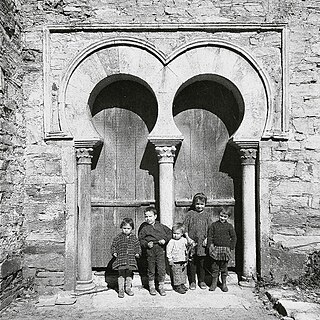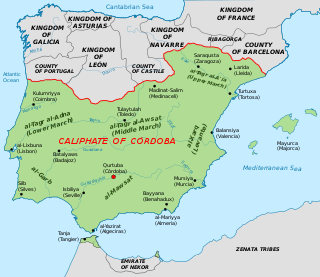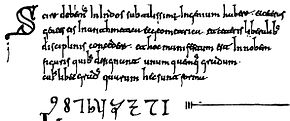
The term Moor is an exonym first used by Christian Europeans to designate the Muslim populations of the Maghreb, al-Andalus, Sicily and Malta during the Middle Ages. Moors are not a single, distinct or self-defined people. The 1911 Encyclopædia Britannica observed that the term had "no real ethnological value." Europeans of the Middle Ages and the early modern period variously applied the name to Arabs, Berbers, and Muslim Europeans.

The Almohad Caliphate or Almohad Empire was a North African Berber Muslim empire founded in the 12th century. At its height, it controlled much of the Iberian Peninsula (Al-Andalus) and North Africa.

Medieval Muslim Algeria was a period of Muslim dominance in Algeria during the Middle Ages, spanning the millennium from the 7th century to the 17th century. The new faith, in its various forms, would penetrate nearly all segments of society, bringing with it armies, learned men, and fervent mystics; in large part, it would replace tribal practices and loyalties with new social norms and political idioms.

The Mozarabs, or more precisely Andalusi Christians, were the Christians of al-Andalus, or the territories of Iberia under Muslim rule from 711 to 1492. Following the Umayyad conquest of the Visigothic Kingdom in Hispania, the Christian population of much of Iberia came under Muslim control.

Al-Andalus was the Muslim-ruled area of the Iberian Peninsula. The name describes the different Muslim states that controlled these territories at various times between 711 and 1492. At its greatest geographical extent, it occupied most of the peninsula as well as Septimania under Umayyad rule. These boundaries changed constantly through a series of conquests Western historiography has traditionally characterized as the Reconquista, eventually shrinking to the south and finally to the Emirate of Granada.
The golden age of Jewish culture in Spain was a Muslim ruled era of Spain, with the state name of Al-Andalus, lasting 800 years, whose state lasted from 711 to 1492 A.D. This coincides with the Islamic Golden Age within Muslim ruled territories, while Christian Europe experienced the Middle Ages.

Andalusi Romance, also called Mozarabic or Ajami, refers to the varieties of Ibero-Romance that developed in Al-Andalus, the parts of the medieval Iberian Peninsula under Islamic control. Romance, or vernacular Late Latin, was the common tongue for the great majority of the Iberian population at the time of the Umayyad conquest in the early eighth century, but over the following centuries, it was gradually superseded by Andalusi Arabic as the main spoken language in the Muslim-controlled south. At the same time, as the northern Christian kingdoms pushed south into Al-Andalus, their respective Romance varieties gained ground at the expense of Andalusi Romance as well as Arabic. The final extinction of the former may be estimated to 1300 CE.

The taifas were the independent Muslim principalities and kingdoms of the Iberian Peninsula, referred to by Muslims as al-Andalus, that emerged from the decline and fall of the Umayyad Caliphate of Córdoba between 1009 and 1031. They were a recurring feature of al-Andalus history.
Convivencia is an academic term, proposed by the Spanish philologist Américo Castro, regarding the period of Spanish history from the Muslim Umayyad conquest of Hispania in the early eighth century until the expulsion of the Jews in 1492. It claims that in the different Moorish Iberian kingdoms, the Muslims, Christians and Jews lived in relative peace. According to this interpretation of history, this period of religious diversity differs from later Spanish and Portuguese history when—as a result of expulsions and forced conversions—Catholicism became the sole religion in the Iberian Peninsula.
This is a timeline of notable events during the period of Muslim presence in Iberia, starting with the Umayyad conquest in the 8th century.

The Muslim conquest of the Iberian Peninsula, also known as the Arab conquest of Spain, by the Umayyad Caliphate occurred between approximately 711 and the 720s. The conquest resulted in the destruction of the Christian Visigothic Kingdom of Spain and led to the establishment of a Muslim Arabian-Moorish state, Al-Andalus.
Muladí were the native population of the Iberian Peninsula who adopted Islam after the Muslim conquest of the Iberian Peninsula in the early 8th century. The demarcation of muladíes from the population of Arab and Berber extraction was relevant in the first centuries of Islamic rule, however, by the 10th century, they diluted into the bulk of the society of al-Andalus. In Sicily, Muslims of local descent or of mixed Arab, and Sicilian origin were also sometimes referred to as Muwallad. They were also called Musalimah ('Islamized'). In broader usage, the word muwallad is used to describe Arabs of mixed parentage, especially those not living in their ancestral homelands.

The Berber Revolt or the Kharijite Revolt of 740–743 AD took place during the reign of the Umayyad Caliph Hisham ibn Abd al-Malik and marked the first successful secession from the Arab caliphate. Fired up by Kharijite puritan preachers, the Berber revolt against their Umayyad Arab rulers began in Tangier in 740, and was led initially by Maysara al-Matghari. The revolt soon spread through the rest of the Maghreb and across the straits to al-Andalus.
Abū ‘Āmir Ibn Gharsīyah al-Bashkunsī, popularly known as Ibn Gharsiya or Ibn García, was a Muwallad poet and katib (writer) in the Taifa court in Denia.

The Emirate of Granada, also known as the Nasrid Kingdom of Granada, was an Islamic polity in the southern Iberian Peninsula during the Late Middle Ages, ruled by the Nasrid dynasty. It was the last independent Muslim state in Western Europe.

The Emirate of Córdoba, from 929, the Caliphate of Córdoba, was an Arab Islamic state ruled by the Umayyad dynasty from 756 to 1031. Its territory comprised most of the Iberian Peninsula, the Balearic Islands, and parts of North Africa, with its capital in Córdoba. From 756 it was ruled as an emirate until Abd al-Rahman III adopted the title of caliph in 929.

Almohad doctrine or Almohadism was the ideology underpinning the Almohad movement, founded by Ibn Tumart, which created the Almohad Empire during the 12th to 13th centuries. Fundamental to Almohadism was Ibn Tumart's radical interpretation of tawḥid—"unity" or "oneness"—from which the Almohads get their name: al-muwaḥḥidūn (المُوَحِّدون).
The literature of al-Andalus, also known as Andalusi literature, was produced in al-Andalus, or Islamic Iberia, from the Muslim conquest in 711 to either the Catholic conquest of Granada in 1492 or the expulsion of the Moors ending in 1614. Andalusi literature was written primarily in Arabic, but also in Hebrew, Latin, and Romance.

Slavery in al-Andalus was a practice throughout Al-Andalus and the Iberian Peninsula between the 8th-century and the 15th century. This includes the periods of the Emirate of Córdoba (756–929), the Caliphate of Córdoba (929–1031), the Taifas, Almoravid rule (1085–1145), Almohad rule (1147–1238), and the Emirate of Granada (1232–1492).



















